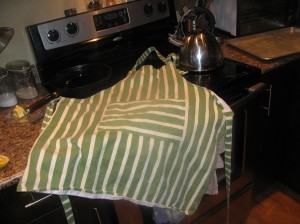Here are a few things that we are using as guiding principles, in decision-making and sorting through scare-mongering (ie: Fukushima).
Permaculture: The idea that, just as forests sustain themselves, we can build gardens/farms/communities that are both productive and self-sustaining. There’s a whole bunch of people that are using permaculture principles to inform their horticulture, and it seems to make farming both less effort and more beautiful/lush/alive than traditional annual fieldcropping.
Transition Towns: Transition is what’s going to happen when we run out of accessible oil and the economy crashes. This might happen next year, or in 20 years, but I’d be surprised if it took that long. Yes, every generation thinks both that the End Of Time is nigh, and that they invented sex, and neither has ever been true, but things seem a bit more doomy this time. The Transition Town movement is a framework for doing some of the transitioning before we have to, which makes the whole thing a bit more comfortable. And if we make a city friendlier for people and less friendly for multi-nationals at the same time, then more yay. Transition Town as a concept was started by permaculturalist Rob Hopkins in Totnes, UK, in 2006, and has spread around the world relatively quickly. “Armies cannot stop an idea whose time has come” (Victor Hugo), &c.
Localism: The idea that the best place to take care of a community’s basic needs is within a specific geographical area. This is how the world used to work, before the age of cheap transportation, and is how it will work again once oil becomes too expensive for the casual shipping of junk from China (for example).
Anarchy: The idea that each person is best able to determine how they live their lives, within the boundaries of contract law. Unless someone has specifically and voluntarily signed a contract, no one could compel them to do anything. No government, no bylaws, just voluntary association. Of course, this requires that people not be assholes (or that we collectively learn how to stand up to assholes, or cultivate our own assholes [sorry for any unintended visual]), which may be too much to ask.
Energy Slave: If we translate our oil use into people-power, we each have about 200 people working for us (given 8 hour days, and weekends and holidays off). We are used to having this amount of energy available to us, 24/7, but it won’t last.
Peak oil: Once we have extracted half the available oil in the world, demand will keep rising but production will peak and then start to decline. We will have removed all the easiest oil, and what is left will be harder and more expensive to extract, leading to a significant rise in oil prices. This will depress the oil-based economy, which will lower the price of oil, which will cause the economy to look like it will recover, which will raise the price of oil, and then repeat the recession. Eventually this cycle will crash the economy. Consensus on this varies, but I’m pretty convinced that we passed peak oil in 2007. I’m also convinced that tar-sands extraction is a desperate attempt by our can’t-see-the-nose-on-their-face government to keep things ‘normal’ for as long as possible, and damn the consequences.
All of this combined presents an interesting picture of the future, but it doesn’t tell us what will happen for us, personally. All possible futures are currently happening somewhere, for someone. Some child is forced into slavery to produce cheap chocolate, and at the same time women are taking control of their own destinies somewhere else. New parks are being created somewhere, and somewhere else corrupt officials are allowing dedicated parkland to be logged. Some people live in Portland, and others live in (not THE) Ukraine, and nobody really knows in which direction a city will go in the next 10 years (see Detroit!) We don’t know what is going to happen, but these are the sorts of things that are informing my decision making process.
Want more info about any of the above (because I have the Mad Links and love to share)? What about your decision making process? Are you thinking about changing how you live?








